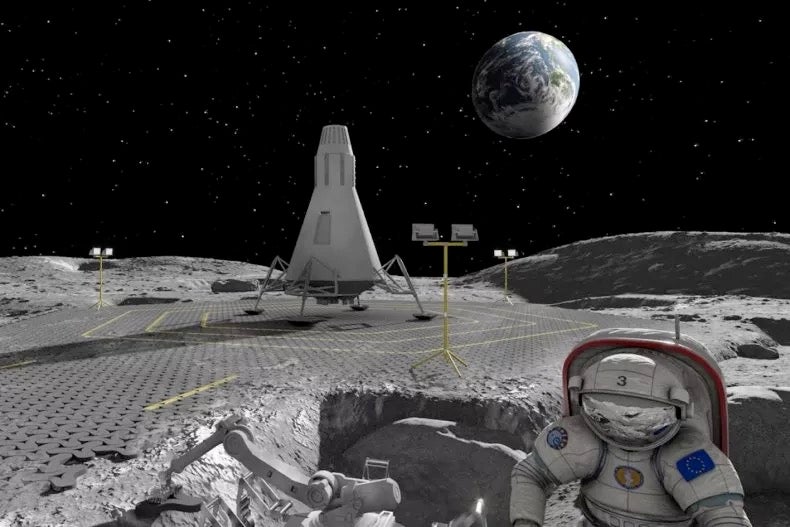
A rendering of what laser-built roads on the moon might look like. Credit: Liquifer Systems Group
Those of us who have ever used a magnifying glass to start stuff on fire, rejoice — it ends up we were doing the same kind of science that could build roads, launch pads, and more on the Moon.
A paper published in Scientific Reports outlines an audacious way to melt the lunar surface into usable materials. The paper suggests all that’s needed is a 7.8-foot (2.37 meters) Fresnel lens. These lenses — which have surfaces covered in concentric circles of glass — focus light really well with less surface area, reducing the amount of material needed to build them. This makes them an ideal choice for use on lunar missions, where space and weight are costly.
In particular, using a Fresnel lens coupled with a laser to fuse lunar regolith would reduce the power (and thus size, weight, etc.) of the laser astronauts would need to tote along, the study finds. Lead author Juan Carlos Ginés Palomares of Aalen University in Germany says it’s the best choice “for its simplicity of design and low weight compared to other regolith heating set-ups such as microwave ovens or electric ovens.”
Turning lunar rock usable
So how do Ginés Palomares and colleagues know it will work? In an experiment, they took a sample of material fabricated by the European Space Agency to simulate lunar regolith, called EAC-1A. They placed it in a graphite crucible — used for its ability to withstand temperatures up to 5,000 degrees Fahrenheit (2,760 degrees Celsius) — with a vacuum pump to simulate the virtually nonexistent atmosphere of the Moon. Then they used a laser with a beam that spreads out across a 3.74 inches (95 millimeters) in diameter to melt the simulated lunar regolith.
Ginés Palomares says initial attempts to build large components stumbled.
“The first interesting discovery was the possibility of manufacturing parts of a fairly wide thickness (up to 25 mm [1 inch]) with a single beam pass,” he says. “The main disappointment was that the parts broke or were damaged when several overlapping paths were made.”
But then an “Ah-ha!” moment came when they were able to create three-sided shapes (like a triangle bent inward) about 0.6 inch (15 mm) thick. These shapes could conceivably be “interlocked to cover a large area of the lunar surface as a solution to the problem,” he says.
Based on various configurations, the team ultimately arrived at the Fresnel lens-laser combo as the best possible option for use on the Moon.
Building materials everywhere
“This process has some outstanding advantages,” Ginés Palomares says. “The first is the use of virtually inexhaustible materials and energies: sunlight and Moon dust.” Given the limitations of bringing building materials to the Moon, and the problems caused by Moon dust, the option of using what’s already there with a setup that’s easy to transport could be transformative for future lunar endeavors.
Phillip Metzger, a planetary physicist at the University of Central Florida and Kennedy Space Center’s Skunkworks who was not involved with the study, studies how to use resources on a planet’s surface to build materials. He says the work is an important step in the right direction.
“The authors identified several challenging phenomena,” he said. “These included the formation of a three-layer material. The top layer is glass. The middle layer is synthetic rock — recrystallized minerals. The bottom layer is a thin sintered layer where complete melting did not occur. This could affect the integrity of construction materials.” Metzger says future studies should focus on controlling these phenomena.
Ginés Palomares agrees the material needs more testing. For example, he would like to subject it to rocket thrust-like conditions to see how it holds up as a launch pad. He also wants to test producing it in low-gravity conditions, such as a parabolic flight, to see how the setup works under realistic lunar gravity conditions. “In particular, the formation of a large pool of molten material under lunar gravity needs to be studied, because in low gravity the pool tends to form a spherical shape due to the dominance of surface tension forces over the gravity force,” he says. That might mean making flattened pieces is trickier, requiring adjustments to the setup or the process.
Nonetheless, while the technology has a few steps to go before it can start paving the first lunar streets, it’s off to a pretty good start.





